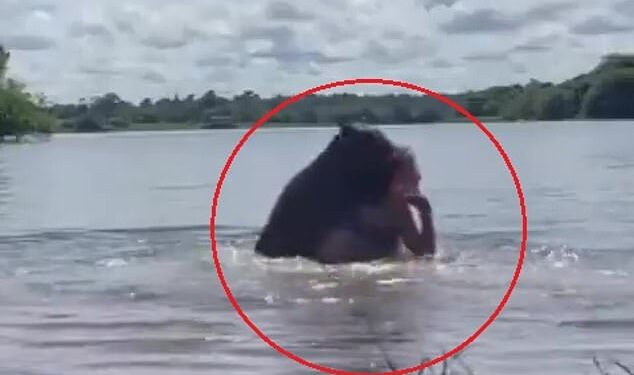This is the shocking moment a woman was attacked by a capybara while swimming in Colombia.
Astonishing video shows how a paddle with the huge rodent took a sinister turn when it launched itself at the swimmer and attacked.
The young victim could be seen in phone footage raising her finger to the animal to warn it to keep its distance.
In an instant it then jumped on her back and seemingly gnawed at her head before she went under the water.
The woman’s cries could be heard as the large animal pushed her out of the frame while snapping at her.
In a stroke of luck, a man arrived on the bank and grabbed a stick to defend the victim as she came to shore, sobbing.
She continued wailing off camera as the massive rodent returned to bobbing quietly in the lake.

The capybara is seen mounting the woman before dragging her under the water

The woman’s head goes under the water as the massive rodent bites at her

The woman wails as she is dragged down by the huge rodent

Capybaras eat grass next to a street in a gated community in Tigre, Buenos Aires province, on August 27, 2021
The scary scenes were filmed in Ciénaga in northern Colombia, as reported by What’s The Jam.
One local said: ‘Just because you’ve seen videos of them being calm and cute, it doesn’t take away from the fact that they are still wild animals.’
Another asked: ‘But why would she swim with it?’
A user who gave her name as Lilith commented: ‘Aren’t capybaras supposed to be calm and friendly?’
Nichi added: ‘Why did it take so long to help her?! The thing was biting her head and face!’
Capybaras, herbivorous rodents, are considered quite docile creatures that will only bite if provoked or threatened.
While semi-aquatic and capable of holding their breath underwater for almost five minutes, they can also run at up to 22 miles per hour.
Their maximum lifespan is between eight and 10 years and they typically weigh between 77 and 146 lbs.

Capybaras are considered quite docile creatures that will only bite if provoked or threatened

Capybaras are semi-aquatic and capable of holding their breath underwater for almost five minutes

The capybara continues to bite at the woman as she is pushed out of the frame
Native to South America, capybaras are the largest living rodents in the world.
They inhabit dense forests and savannas and live near bodies of water.
Popular folklore holds that Venezuelan clergymen wrote to the Pope ‘sometime between the 16th and 18th century’ telling how they had discovered an animal that lived in water and had webbed feet.
They asked for the Vatican to grant the animal the status of fish, so that they might eat it during Lent, when many were preparing to fast from meat.
The Catholic Church agreed and the capybara reserves special gastronomical status, served as a delicacy around Easter to this day in parts of South America.
The world’s largest rodent is said to taste more like salty pork than fish.
The escape of a young capybara from a Shropshire zoo prompted an online craze late last year.
Cinnamon the capybara escaped from Hoo Zoo and Dinosaur World on September 13 after being startled by a tractor mower.
She was quickly spotted with a thermal drone some 200 metres from the zoo’s perimeter.
Seen quietly enjoying grazing in luscious fields, owner Will said she was probably ‘living her best life’.

A man armed with a stick arrives on the scene to help

Fugitive rodent Cinnamon escaped from her enclosure in September last year
Before her rescue, fears were raised Cinnamon could have strayed onto bordering Ministry of Defence land.
Cinnamon was thankfully caught on September 20, coaxed into a cage by rescuers.
The zoo looking after Cinnamon said the story had seen huge interest in their work and inspired teddies, magnets and clothing.
A children’s book was reportedly being written, and Will said that he even kept ‘hearing rumours’ of a film in the works.







